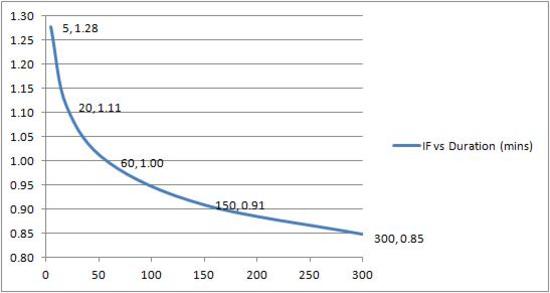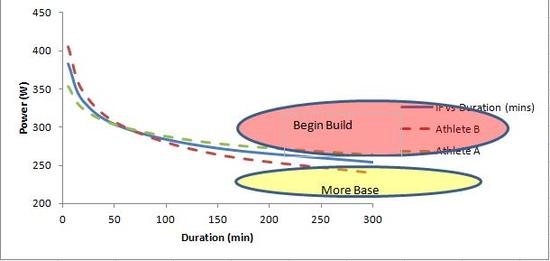With the spring season starting up, many athletes will begin to wonder, “How much base training is enough?” or “When is the right time to start some faster workouts?” In terms of the TrainingPeaks Annual Training Plan, athletes may wonder if they should continue the Base phase or enter the Build phase of training.
There is a great tool within the TrainingPeaks product line that can help you answer this question. It’s called the Peak Power curve, and it’s a chart you can access once you have a TrainingPeaks account for their online training log.
In dealing with athletes as a power-based coach over several years, I’ve come to identify some telltale training benchmarks that let me know whether the athlete needs more base work, or is ready to begin a phase of higher intensity training.
For an Ironman athlete, these Peak Power benchmarks are shown below.

The benchmarks are presented in terms of intensity factor® (IF®), essentially percent of functional threshold for each duration (in minutes), as the absolute power numbers will vary depending on the fitness of the athlete and how high his or her functional threshold power might be. However, irrespective of absolute fitness, endurance remains a high priority for Ironman athletes of all levels. For this reason, I ask all my Iron-distance athletes to be able to complete a long ride at a rather high percentage of FTP before concluding that a sufficient level of basic endurance for Ironman has been built.
To further illustrate, a couple of real-world Peak Power curve examples are shown below for two athletes with a functional threshold power (FTP) of 300W. For this level of FTP, I put the 2.5- and 5-hour “cut off” line at 273W (300 x 0.91) and 255W (300 x 0.85) respectively. Athlete A hits these marks with a 2.5-hour best of 279W and a 5-hour best of 264. Athlete B, while equally fit in an FTP sense, falls short of these marks with a 2.5-hour best of 264W and a 5-hour best of 240W. So, at this point in the season, I would plan a higher intensity build period for the first athlete, while continuing a base focus for the second.

The vast majority of Ironman athletes will fall below the line, and for this reason I agree with Gordo Byrn when he states in his book Going Long, “If in doubt between Base and Build, choose Base.” That said, there are athletes out there who may have developed a disproportionate strength on the endurance side of the curve, whether through genetic factors (fiber type), or just a long history of base emphasis. These athletes can benefit from a period of higher intensity focus to “raise the roof” and give themselves a little more room to work with before their next period of endurance focus.
I will use a similar approach for athletes preparing for short course events; however, the standards will be more moderate and the likelihood of a build phase will be significantly higher. In this case, I’ll use these standards to help determine how long the build phase might be rather than if it’s included at all.
Whatever the distance you’re preparing for, the Peak Power curve is a great tool to assess how specifically prepared you are for the endurance demands of your event. By observing it through the season, you can understand if you should be training further or faster.



